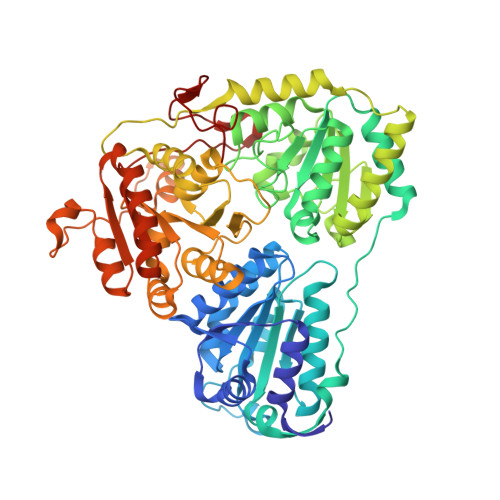Engineering of two thiamine diphosphate-dependent enzymes for the regioselective condensation of C1-formaldehyde into C4-erythrulose.
Kim, J.H., Cheon, H., Jo, H.J., Kim, J.W., Kim, G.Y., Seo, H.R., Seo, P.W., Kim, J.S., Park, J.B.(2023) Int J Biol Macromol 253: 127674-127674
- PubMed: 37890751
- DOI: https://doi.org/10.1016/j.ijbiomac.2023.127674
- Primary Citation of Related Structures:
8I01, 8I05, 8I07, 8I08 - PubMed Abstract:
A number of carboligases, which catalyze condensation of C1- and/or C2-aldehydes into multi-carbon products, have been reported. However, their catalytic activities and/or regioselectivities remained rather low. Thereby, this study has focused on engineering of C1 and C2 carboligases for the regioselective condensation of C1-formaldehyde into C4-erythrulose via C2-glycolaldehyde. The crystal structure of the glyoxylate carboligase from Escherichia coli (EcGCL) was elucidated in complex with glycolaldehyde. A structure-guided rationale generated several mutants, one of whose catalytic activity reached 15.6 M -1 ·s -1 , almost 10 times greater than the wild-type enzyme. Another variant (i.e., EcGCL _R484M/N283Q/L478M/M488L/R284K ) has shown significantly increased stability to the glycolaldehyde toxicity, enabling production of glycolaldehyde to 31 mM from 75 mM formaldehyde (conversion: 83 %). Besides, the E1 subunit of α-ketoglutarate dehydrogenase complex from Vibrio vulnificus (VvSucA) was engineered as a regiospecific C2 carboligase for condensation of glycolaldehyde into erythrulose. The combination of EcGCL _R484M/N283Q/L478M/M488L/R284K and VvSucA _K228L led to the cascade production of erythrulose to 8 mM from 90 mM formaldehyde via glycolaldehyde without byproduct formation. This study will contribute to valorization of C1 gases into industrially relevant multi-carbon products in an environment-friendly way.
- Department of Chemistry, Chonnam National University, Gwangju 61186, Republic of Korea.
Organizational Affiliation:




















